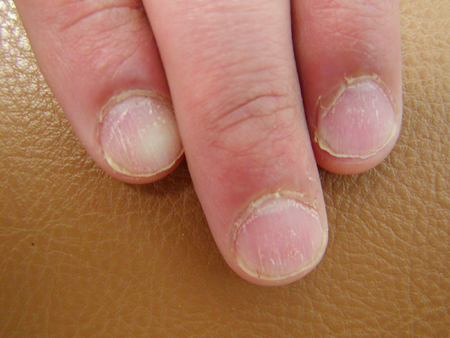Approach
Patients typically present complaining of acute onset of hair shedding or a newly recognized bald spot. Patients are usually otherwise asymptomatic, but at times may have an odd sensation or discomfort in an area of active or developing alopecia. History should include onset, duration, and location of hair loss; family history of alopecia; and personal or family history of atopy or other autoimmune diseases.[17]
Examination
Physical examination will reveal bare, round patches of hair loss with retained follicular ostia. The underlying skin may be normal in appearance. The diagnosis is made clinically and may be aided by a positive hair pull test at the periphery of the alopecia areata (AA), indicating an active stage of disease. [Figure caption and citation for the preceding image starts]: Hair pull testProvided by Paradi Mirmirani, MD [Citation ends].
The pull test is done by grasping a pinch of closely grouped hairs (or about 50 hairs) between the thumb and the index and middle fingers, and gentle traction is applied as the fingers are pulled firmly and slowly away from the scalp. Normally, 2 to 5 hairs will be obtained in this manner. More than 5 hairs is considered to be a positive pull test. A pathognomonic feature of an AA patch is exclamation point hairs that may be present within a patch of hair loss. Exclamation point hairs are broken, short hairs that taper proximally at the scalp.
The most common pattern of AA is coin-sized, round or oval patches of hair loss. Hair loss can also present in an ophiasis or band pattern along the inferior aspect of the parieto-occipital scalp. Less commonly, the whole scalp may be involved (alopecia totalis) or the whole body including beard and body hair (alopecia universalis). A diffuse presentation of AA is very rare. Nail pitting is seen in 10% to 66% of patients with AA.[8][Figure caption and citation for the preceding image starts]: Nail pitting in alopecia areataProvided by Paradi Mirmirani, MD [Citation ends].
Tests
A scalp biopsy may be helpful in atypical presentations where the diagnosis is not clear. Thyroid autoantibodies may be positive in some patients with AA. Trichoscopy may aid diagnosis. Characteristic findings include the presence of yellow dots, black dots, broken hairs, or more classic exclamation point hairs.[12][18]
Use of this content is subject to our disclaimer